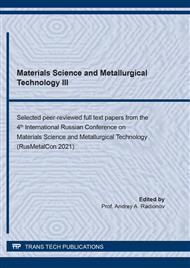[1]
A.V. Malakhov, Design algorithm of rational fiber trajectories in arbitrarily loaded composite plate, Journal of Machinery Manufacture and Reliability. 46(5) (2017) 479-487.
DOI: 10.3103/s1052618817050090
Google Scholar
[2]
C.K. Krishnadasan, N.S. Shanmugam, B. Sivasubramonian, B.N. Rao, R. Suresh, Analytical studies and numerical predictions of stresses in shear joints of layered composite panels for aerospace applications, Composite Structures. 255 (2021) 112927.
DOI: 10.1016/j.compstruct.2020.112927
Google Scholar
[3]
A. Ghazlan, T. Ngo, P. Tan, Y. Min Xie, P. Tran, M. Donough, Inspiration from nature's body armours – A review of biological and bioinspired composites, Composites Part B: Engineering. 205 (2021) 108513.
DOI: 10.1016/j.compositesb.2020.108513
Google Scholar
[4]
A.N. Polilov, N.A. Tatus, Strength Biomechanics of Fiber Composites, Fizmatlit, Moscow, (2018).
Google Scholar
[5]
A.N. Polilov, N.A. Tatus', X. Tian, Analysis of efficiency of uniform-strength composite leaf springs under various loading conditions, Journal of Machinery Manufacture and Reliability. 48 (5) (2019) 431-439.
DOI: 10.3103/s105261881905008x
Google Scholar
[6]
M. Fakoor, M.S. Khezri, A micromechanical approach for mixed mode I/II failure assessment of cracked highly orthotropic materials such as wood, Theoretical and Applied Fracture Mechanics. 109 (2020) 102740.
DOI: 10.1016/j.tafmec.2020.102740
Google Scholar
[7]
S. Wasti, E. Triggs, R. Farag, M. Auad, S. Adhikari, D. Bajwa, M. Li, A.J. Ragauskas, Influence of plasticizers on thermal and mechanical properties of biocomposite filaments made from lignin and polylactic acid for 3D printing, Composites Part B: Engineering. 205 (2021) 108483.
DOI: 10.1016/j.compositesb.2020.108483
Google Scholar
[8]
A.N. Polilov, N.A. Tatus, X. Tian, Analyzing the correctness of equal strength composite profiled beam bending problems, Journal of Applied Mechanics and Technical Physics. 60(1) (2019) 144-155.
DOI: 10.1134/s0021894419010188
Google Scholar
[9]
R. Tao, L. Ji, Y. Li, Z. Wan, W. Hu, W. Wu, B. Liao, L. Ma, D. Fang, 4D printed origami metamaterials with tunable compression twist behavior and stress-strain curves, Composites Part B: Engineering. 201 (2020) 108344.
DOI: 10.1016/j.compositesb.2020.108344
Google Scholar
[10]
Z. Hou, X. Tian, J. Zhang, Z. Zheng, L. Zhe, D. Li, A.V. Malakhov, A.N. Polilov, Optimization design and 3D printing of curvilinear fiber reinforced variable stiffness composites, Composites Science and Technology. 201 (2021) 108502.
DOI: 10.1016/j.compscitech.2020.108502
Google Scholar
[11]
F. París, M.L. Velasco, E. Correa, The scale effect in composites: An explanation physically based on the different mechanisms of damage involved in failure, Composite Structures. 257 (2021) 11308.
DOI: 10.1016/j.compstruct.2020.113089
Google Scholar
[12]
H. Saito, H. Takeuchi, I. Kimpara, A study of crack suppression mechanism of thin-ply carbon-fiber-reinforced polymer laminate with mesoscopic numerical simulation, Journal of Composite Materials. 48(17) (2014) 2085-2096.
DOI: 10.1177/0021998313494430
Google Scholar
[13]
J. Serra, C. Bouvet, B. Castanié, C. Petiot, Scaling effect in notched composites: The discrete ply model approach, Composite Structures. 148 (2016) 127-143.
DOI: 10.1016/j.compstruct.2016.03.062
Google Scholar
[14]
Y. Zhang, X. Xu, Predicting the delamination factor in carbon fibre reinforced plastic composites during drilling through the Gaussian process regression, Journal of Composite Materials. 55(15) (2021).
DOI: 10.1177/0021998320984245
Google Scholar
[15]
M. Umair, M. Hussain, Z. Abbas, K. Shaker, Y. Nawab, Effect of weave architecture and glass microspheres percentage on the low velocity impact response of hemp/green epoxy composites, Journal of Composite Materials. 55(16) (2021).
DOI: 10.1177/0021998320987605
Google Scholar
[16]
N.A. Tatus, A.N. Polilov, D.D. Vlasov, E.K. Akhmedshin, A special specimen shape for adequate determination of tensile strength of a unidirectional fiber-reinforced composite, AIP Conference Proceedings. 2315 (2020) 040044.
DOI: 10.1063/5.0036628
Google Scholar
[17]
K.A. Brauning, A. Kunza, I.M. Alarifi, R. Asmatulu, Mitigations of machine-damaged free-edge effects on fiber-reinforced composites, Journal of Composite Materials. 55(12) (2021).
DOI: 10.1177/0021998320967987
Google Scholar
[18]
A.N. Polilov, N.A. Tatus, I.S. Kamantsev, A.V. Kuznetsov, E.Kh. Akhmedshin, X. Tian, Reducing the effect of holes on the bearing capacity of fiber-reinforced materials, AIP Conference Proceedings. 2176 (2019) 030010.
DOI: 10.1063/1.5135134
Google Scholar
[19]
E.Kh. Akhmedshin, A.N. Polilov, N.A. Tatus, Reducing of holes effect on composite elements strength, IOP Conference Series: Materials Science and Engineering. 848 (1) (2020) 012088.
DOI: 10.1088/1757-899x/848/1/012088
Google Scholar
[20]
F.A.O. Fernandes, J.P. Tavares, R.J. Alves de Sousa, A.B. Pereira, J.L. Esteves, Manufacturing and testing composites based on natural materials, Procedia Manufacturing. 13 (2017) 227-234.
DOI: 10.1016/j.promfg.2017.09.055
Google Scholar
[21]
S.W.F. Spronk, E. Verboven, F.A. Gilabert, R.D.B. Sevenois, D. Garoz, M. Kersemans, W. Van Paepegem, Stress-strain synchronization for high strain rate tests on brittle composites, Polymer Testing. 67 (2018) 477-486.
DOI: 10.1016/j.polymertesting.2018.02.008
Google Scholar
[22]
A. Komorek, R.Szczepaniak, P. Przybylek, A. Krzyzak, J. Godzimirski, M. Roskowicz, D. Seremak, Properties of multi-layered polymer composites with Vectran fiber reinforcement, Composite Structures. 256 (2021) 113045.
DOI: 10.1016/j.compstruct.2020.113045
Google Scholar
[23]
G. Yamamoto, K. Koizumi, T. Nakamura, N. Hirano, T. Okabe, Tensile-strength-controlling factors in unidirectional carbon fiber reinforced plastic composites, Composites Part A: Applied Science and Manufacturing. 140 (2021) 106140.
DOI: 10.1016/j.compositesa.2020.106140
Google Scholar


